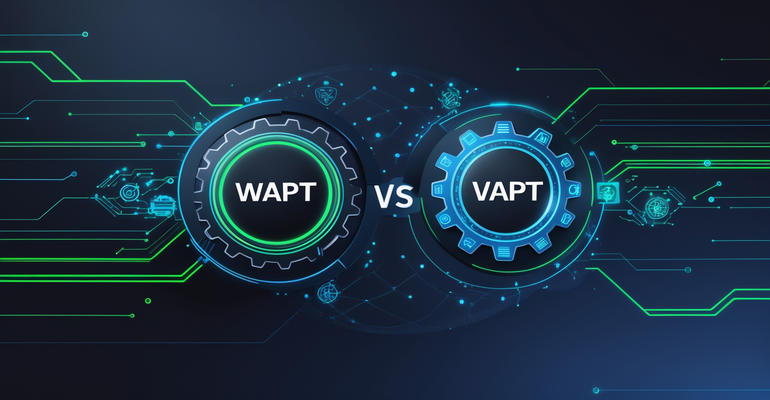Web applications serve as the backbone of businesses across industries. WAPT and VAPT are vital for businesses to enhance cybersecurity. However, with the increasing sophistication of cyber threats, securing these applications has never been more critical. Web Application Penetration Testing (WAPT) is a specialized security assessment method designed to uncover vulnerabilities that attackers could exploit. Unlike traditional security testing, WAPT focuses on application-layer weaknesses, such as authentication flaws, injection attacks, and session management issues. This blog explores the key objectives, tools, and industry applications of WAPT, along with its broader counterpart, Vulnerability Assessment and Penetration Testing (VAPT), to help businesses make informed security decisions.
Understanding WAPT
Web Application Penetration Testing (WAPT) is one of the more advanced types of testing where real-life scenarios are used to analyze weaknesses in the security defenses of a business’s web applications. The objective is to find exploitable gaps within systems which if left unchecked, could be viciously embraced by hostile entities and suggest remediation plans that are productive.
Unlike some types of security testing, WAPT emphasizes application level problems like authentication issues, session management issues, injections, and other configurations gone wrong.
Key Objectives of WAPT
Identify Security Weaknesses: Find common vulnerabilities such as SQL, cross-site scripting, broken authentication, and insecure direct object references.
Assess Business Impact: Analyze the nature scope of damage which can be inflicted due to loss of breach, and how it can impair other functions like customer relations, trust garnish, and regulatory compliance.
Evaluate Security Controls: Analyze prevention tools like firewalls, access restriction protocols, and data encryption frameworks provisions.
Ensure Compliance: Comply with required standards such as OWASP Top 10, PCI-DSS, GDPR and ISO 27001.
Provide Remediation Guidance: Suggest appropriate methods of rectifying identified gaps and bettering overall security of web applications.
Common Tools Used For WAPT
A mix of automated and manual tools is employed in WAPT to carry out the in-depth evaluation. The most popular tools are listed as follows:
Burp Suite – A premier intercept tool that offers modification and analysis of web traffic.
OWASP ZAP (Zed Attack Proxy) – A freely available vulnerability scanner that serves for security inspections.
Nmap: Useful for discovering networks and performing security audits.
SQLMap: A tool that automates the detection and exploitation of SQL injection vulnerabilities.
Nikto: A web server scanner that finds outdated and misconfigured software.
Metasploit: A well-known penetration testing framework that can exploit various vulnerabilities.
Wfuzz: A web application testing tool used to perform brute force attacks.
Industries that benefit the most from WAPT
Financial Services: Banks, payment processors, and fintechs need to protect valuable customer and transaction data.
Healthcare: Hospitals and telehealth providers must protect patient data in accordance with HIPAA regulations.
E-commerce: Online retailers protect sensitive payment information and fraud.
Government and Public Sector: Public sector institutions strive to protect their sites and portals from cyberattacks.
Technology and SaaS Providers: Customer data stored in cloud applications and services needs to be well protected.
Education: Online schools and universities must protect their students and faculty from fraud.
Telecommunications: Customers and service data are under constant threat of cyberattacks; therefore, telecoms must strengthen their online services security.
Understanding VAPT
Vulnerability Assessment and Penetration Testing (VAPT) is a cybersecurity methodology used to identify, assess, and remediate security vulnerabilities in an organization’s systems, networks, and applications. It combines two essential security testing approaches- vulnerability Assessment (VA) and Penetration Testing (PT) – to provide a comprehensive evaluation of security risks.
Breakdown of the two components:
Vulnerability Assessment (VA):
This is a structured method of scanning and locating security risks such as the IT infrastructure, applications, and networks.
Emphasizes the use of automated tools to seek and analyze known flaws and other potential configuration problems.
Provides a rating and suggests measures for associated risks, but has no intention of rectifying the problems on hand.
Penetration Testing (PT):
Covers the application of simulated real world cyber-attacks aiming to utilize identified risks and evaluate their gravity.
Uses automating systems or alternatively manual means of employing methods that an unethical computer programmer would use to investigate weaknesses within the computer system of an institution.
Helps an organization understand the measures an attacker could take for wrongful intrusion and what information would be stolen.
Goals and objectives:
Reveal lacking security measures: Identify threats within applications, establishments, and systems.
Lessen chances of a cyber attack: Sufficiently checking security loopholes intervenes with chances of exploitation and loss of sensitive data.
Ensure compliance: Also make sure these requirements are met; GDPR, ISO 27001, PCI DSS, HIPAA, SOC 2.
Improve overall Security: Enhances positive changes with insight as to the recommended overall cybersecurity measures an organization has to adopt.
Prevent Leakage of Sensitive Data: Restrict unauthorized access and limit information dissemination.
Common VAPT Tools
In the VAPT category, the tools list includes two subcategories: the Vulnerability Assessment (VA) tools and the Penetration Testing (PT) tools, each has its very distinct function in solving a security problem.
Nessus – This is one of the most popularly known scanners which compare standards and find deviations with respect to security holes, vulnerability, gappage or infrastructure misconfigurations within IT systems.
OpenVAS – A freely available web-based application that has all the needed components to detect weaknesses in networks and sub-applications.
Metasploit – This tool has the ability to exploit a system’s weaknesses in order to test the integrity of the system’s protection mechanisms.
Burp Suite – This tool helps to automate the scanning for app vulnerabilities such as cross-site scripting (XSS), SQL injection, etc.
Nmap (Network Mapper) – This tool permits a user to get familiarized with and map a computer network’s open ports, services processes, and other computer security problems.
Wireshark – A tool for analyzing computer network protocols traffic for information capture, detection of security breaches and abnormal behaviour of a system.
SQLmap – This is a tool used for testing security during SQL exploits to automate the process of detecting and exploiting SQL injection vulnerabilities in a database.
Industries Which Have A Need For VAPT
Finance & Banking: Used to safeguard financial information, customer activity, payments done.
Healthcare: HIPAA compliance and safeguarding sensitive patient records.
E-commerce & Retail: Payments through e-commerce websites and protecting sensitive information.
Defense contractors: Protects sensitive and important data and facilities in order to enhance the security of the nation.
Software and technology services: Provides protection of cloud services, SaaS platforms and customer data.
Service providers: Protects communication systems and networks against breaches.
Schools: Protect sensitive information concerning students and faculty from cyber attacks.
How To Choose The Right Approach For Your Business?
Selecting the most effective security testing method – either Web Application Penetration Testing (WAPT) or Vulnerability Assessment and Penetration Testing (VAPT) – is contingent on several factors. These factors include specific business requirements, the legal structure, and risk mitigation strategies.
Key Considerations for Choosing the Right Approach:
1. Business Type & Industry
E-commerce and SaaS businesses that primarily function through web applications must consider WAPT.
If your company has networks, servers, and more IT infrastructure aside from web applications, then VAPT would suit your organization type better.
2. Compliance Requirements
Finance, healthcare, and governmental industries require stricter security measures to comply with PCI DSS, HIPAA, ISO 27001, and GDPR, and so security testing is essential.
In comparison to WAPT, VAPT is much more effective in meeting these industry standards because it examines the entire IT system for risks.
3.Security Risk Level
WAPT protects web applications that process sensitive customer information from threats, such as SQL Injection attacks, cross-site scripting, and authentication vulnerabilities.
For a blanket assessment that encompasses both networks and applications, VAPT stands supreme.
4.Budget & Resources
Businesses solely concerned with security for their websites will find WAPT more economical.
VAPT is more expensive but offers a complete security assessment for all IT systems, making it more resource intensive.
5.Testing Frequency & Business Growth
Benefits Of Implementing WAPT & VAPT
Early Detection of Vulnerabilities – Focusing on flaws before cybercriminals attack mitigates security issues.
Regulatory Compliance – Aid businesses in evading legal liability by complying with regulations regarding security.
Enhanced Customer Trust – Improvement of the brand image due to proper handling of sensitive information.
Cost Savings – Losing money due to cyber assaults is prevented by solving underlying issues earlier on.
Improved Security Posture – Lessens chances of a cyber security threat while improving defenses.
Business Continuity – Decreases downtime caused by cyber challenges.
Conclusion
For businesses aiming to bolster their cybersecurity posture, comply with regulations, and safeguard sensitive information from possible breaches, WAPT and VAPT implementations are crucial. Selecting an appropriate strategy whether it is securing web applications or performing a full-blown IT security assessment can optimize trust from customers and stakeholders while meaningfully reducing risk. With the proper tools and approaches, businesses can defend themselves from emerging threats and strengthen their security posture in a highly digitized world.






